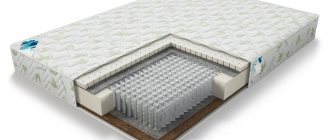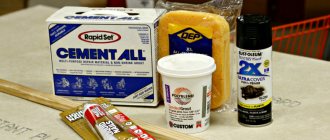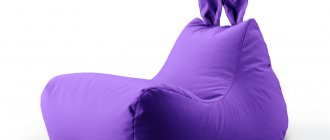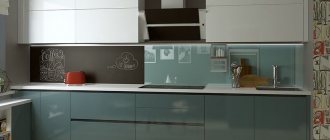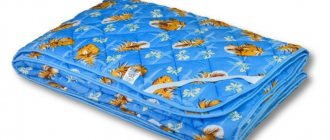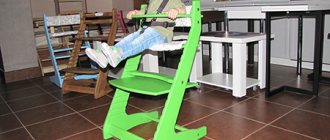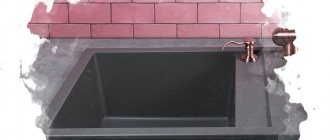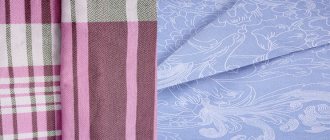08/21/2018 Category: Springless mattresses
- 1 Should I choose a cotton mattress?
- 2 Types of fillers 2.1 Natural
- 2.2 Regenerated wool
- 2.3 Improved
More than one generation of Soviet citizens grew up on cotton mattresses. Every resident of the post-Soviet space, probably, in one way or another also had to evaluate his “orthopedic” characteristics - on the train, in the army, with his grandmother in the village. Factories in Russia today, as in the good old days, continue to sew cotton wool products for sleeping. But is modernity compatible with a cotton mattress, the production technology of which has remained virtually unchanged since Soviet times? What can you say about the quality of sleep on a cotton wool “bed”?
Differences between polyurethane foam and foam mattresses
There are no significant differences between the materials. The chemical formula of foam rubber and polyurethane foam is the same, the starting components are the same, but special additives are allowed in the structure. In this regard, differences may appear in the degree of rigidity and in the speed of restoration of the original shape after loading.
Nowadays, “foam rubber” is usually called a low-density polyurethane foam mattress. Next we will cover the topic of the density of such mattresses.
A careful assessment of the characteristics will allow you to decide on purchasing the most suitable mattress material.
Hardness degree
Unfortunately, to simplify the definition of mattresses by material, criteria are used that often do not reflect their actual differences. For example, among inexperienced sellers, thin inexpensive mattresses are usually called foam rubber, and dense PU foam mattresses with increased product rigidity are called polyurethane foam. Therefore, always check the density and hardness of the material. It is important to understand that the required hardness is achieved during the preparation of the chemical composition before the production of blocks, and also depends on the features and production procedure.
There are several degrees of hardness of polyurethane foam mattresses, depending on the type of additives used.
- Very soft mattresses are based on thin and inexpensive foam rubber, which is not able to support the body in a comfortable position and ensure uniform distribution of the load on the spine and back during rest. We categorically do not recommend using such mattresses.
- Soft mattresses resemble a feather bed in which a person sinks, as if in a cloud of fluff. Increased softness creates extraordinary comfort for relaxation, but is not always beneficial for the spine. If such surfaces are recommended by an orthopedic doctor, then you should place an order without hesitation, otherwise you should pay attention to the next type.
- Medium-hard mattresses do an excellent job of supporting the body in a comfortable position, take an anatomical shape, and do not press through. A distinctive feature can be considered the slow restoration of the original shape. These mattresses are suitable for most people and last much longer than the first two types.
The nuances of self-repair of upholstered furniture
Repairing a sofa with your own hands is a process that may require not only replacing foam rubber, but also upholstery or parts of the frame.
Before you start restoring a sofa, decide whether you will limit yourself to just replacing the filling, or at the same time change the upholstery. And then prepare all the materials in the required quantity. To do this, measure all parts of the furniture and select new filling and fabric for upholstery, adding allowances for hems and seams.
Dismantling the sofa occurs in several stages:
- First you need to remove the sides and, if possible, disconnect the backrest.
- Then the transformation mechanism is removed. Take a photo of each stage to eliminate errors during subsequent assembly, and put marks on the parts to determine which side they were removed from.
Carefully inspect the frame of the product: it is usually made of chipboard and some parts may need to be repaired or replaced. For example, if the sofa made an unpleasant squeak when you sat on it, you need to check the plywood that makes up its bottom - most likely, the sheet has begun to “walk” in the grooves. Secure it with nails and glue it - this will help get rid of the sound.
- After this, you need to remove the upholstery from each element. This is where a staple remover or a flathead screwdriver comes in handy for removing staples.
The old upholstery needs to be washed and thoroughly ironed, in which case it can be used to make a pattern if you want to cover the furniture with new fabric. This will also help restore the appearance of the material for further use (if it does not yet require replacement). The same applies to the used filler - new parts can be cut out of it.
- After this, the actual replacement of foam rubber in the sofa begins.
The cut filler is placed directly on the wooden base of each part, pressed firmly and secured with staples using a construction stapler. At this stage, you can add volume to the back and armrests due to a thicker layer of filler on these elements. But don’t get carried away: a larger volume will require a larger size of upholstery fabric, which means it will no longer be possible to use the material that was originally there. By the way, for the sides and back, you can replace the foam rubber with a softer one - these parts usually do not bear much load, and the price of such filler is less. If there was a spring block in the seat, you need to lay a layer of dense fabric directly on it and fix it separately.
- For the next step you will need canvas or any other similar dense fabric. Each part is covered with it so that the filler fits more tightly and its layer is even. This will also help protect the foam rubber in the sofa from dust and dirt from the upholstery.
- After all the main work is completed, it's time to start sheathing.
Of course, the highest quality and most durable material for upholstery is tapestry. It looks great and can be easily cleaned with special detergents, but it is also quite expensive. Most often, for home repairs of a sofa, they try to choose flock, velor or jacquard. Any of these fabrics has its own advantages and looks good on upholstered furniture. But you shouldn’t take artificial leather for such work - it’s quite difficult to stretch it evenly on your own, in this case it’s better to trust experienced craftsmen.
Pull the fabric tightly and secure with the same staple gun. The staples should be located on the underside of the parts, in no case getting into the joints and abutments of the parts, otherwise they may tear the upholstery and the sofa will fold poorly.
- After this, you can begin assembly. Connect all parts in reverse order. A pre-prepared photo or video of the disassembly process will help you with this.
So, now you can imagine how to change the foam in upholstered furniture with your own hands. This process, of course, is labor-intensive, but it perfectly restores the performance characteristics of the sofa and allows you to save money on buying new furniture.
Thickness
The thickness of foam mattresses can start from 7 cm and reach up to 30. We do not recommend using mattresses below 10-14 cm as an independent sleeping place for an adult.
A mattress with a foam thickness of 10 cm or more is an excellent and affordable alternative to models made from other materials. For its manufacture, the manufacturer usually chooses high-density polyurethane foam, which guarantees:
- correct distribution of the load on the body,
- rapid return of the material to its original state, regardless of the strength and duration of the load,
- adjustment to the anatomical features of the owner.
Customer Reviews
Most often, consumers are satisfied with the modern quality of cotton mattresses. In their reviews, customers report that the products are quite soft, voluminous and contain dense padding. The natural fabric from which the covers are made, as well as a wide range of sizes, satisfy the needs of those who choose cotton models.
Mattresses without springs are used as an additional sleeping place, placed on the bed, or on top of the hard seat of a sofa or chair. Cotton products are used to complement too hard sleeping areas. From the reviews you can find out that one of the advantages for buyers is the low price of the product.
Photo: Cotton mattress
However, there are also some disadvantages when buying a cotton mattress. Some believe that 7-8 cm of product height is not enough for a comfortable sleep, and the filler is unevenly distributed. In addition, there is no way to choose the desired fabric color for the cover.
Other negative reviews are more likely directed at unscrupulous manufacturers who provide incorrect information on tags or in product descriptions on the website.
Often, regenerated cotton wool filler, which costs less, is passed off as white natural fiber.
Advantages
- Hardness
A wide range of mattresses that differ in density allows customers to choose a model that suits their hardness. Excessively soft polyurethane foam is suitable for short-term sleep or rest, since prolonged exposure to such a base can negatively affect the spine. - Strength
One of the features of foam rubber is its porosity, which provides tear resistance. It is advisable to eliminate mechanical loads such as jumping on the surface, which will significantly extend the service life. - Viscosity
Mattresses can be purchased for people with greater weight due to the high degree of viscosity of the material. One clarification: you need to choose dense polyurethane foam. - Weight
Polyurethane foam mattresses are lightweight due to the porous structure of the material. The properties of such models resemble spring versions. - Cost
The bulk of foam mattresses are presented on the market at prices affordable to consumers. Among the cheap options, you can choose products that are small in thickness and quite soft, for the manufacture of which inexpensive materials are used.
What is PPU
The polyurethane foam with which the foam mattress is filled is a porous substance of artificial origin, consisting of air-filled cells. During production, the liquid composition is foamed and then hardened.
Polyurethane foam consists of 90% air. It has enhanced heat retention properties.
PPU is used almost everywhere. It is widely used, filling furniture, bedding, making children's toys, dishwashing sponges, and washcloths.
As a filler, it is valued because of its density. It makes the finished product, such as a mattress, both elastic and soft.
Foam rubber is produced in the format of small sheets or large, strong slabs.
Low-quality material quickly begins to crumble during use, making it impossible to use, so the mattress needs to be replaced.
Flaws
- The service life of polyurethane mattresses is shorter than that of mattresses with springs or coconut coir filling.
- When exposed to high temperatures (smoldering, combustion), the material releases toxic substances.
- According to some experts, foam rubber is not 100% safe when using mattresses.
- Polyurethane foam has low moisture transfer, so drying takes longer than desired.
How to replace foam rubber in a sofa with your own hands
No matter how durable and high-quality the sofa is, over time it becomes unusable. Undoubtedly, if the transformation mechanisms are out of order or the frame is broken, it is better to replace the furniture. But what to do if the sofa is still durable, but the upholstery has worn out, and lumps or holes have appeared in the seat? In this case, you can solve the problem yourself.
There are different types of fillers for upholstered furniture: foam rubber, PPA, cotton wool, synthetic fluff - which are used not only individually, but also in various combinations. For example, a seat is stuffed with polyurethane foam, and sofa cushions with padding polyurethane, or a layer of batting and coconut coir is placed on a spring block, and the top is covered with padding polyester. Modern manufacturers most often choose foam rubber and its more durable analogue – PPA – for filling upholstered furniture.
Products made from foam rubber have several distinctive properties. We are talking about their durability, hypoallergenicity and ability to dry quickly when wet without becoming moldy.
Tips for choosing a foam mattress
To ensure that your purchase does not cause harm to your health, you should carefully choose a polyurethane mattress. Offers to buy a product filled with foam rubber chips or from an unknown manufacturer should be avoided. It is impossible to justify spending a lot on purchasing a counterfeit product that will cause a lot of inconvenience during sleep and poor health after rest.
When choosing a foam mattress, you can focus on the following rules:
- avoid shopping in street markets, in stores that cannot provide certificates
- on product quality, manufacturer documents and other papers;
- perform an elasticity test, which will manifest itself in the elasticity of the material and the rapid restoration of its original state after deformation;
- review the internal material by contacting the manager or seller;
- test by lying on the surface, if possible;
- give up mattresses that are too soft and will not benefit your health;
- select options of high and medium degrees of hardness, guaranteeing good sleep,
- restorative rest, positive effect on the spine due to orthopedic characteristics.
Important! Before purchasing a model with orthopedic properties, you should make an appointment with an orthopedic doctor, who will be able to suggest a polyurethane foam mattress model of suitable hardness. The basis for the choice will be the characteristics and needs of the patient’s body. It is important not to self-medicate!
Many buyers were able to appreciate mattresses made from combined materials. In such cases, foam rubber is on one side, and, for example, coconut coir is on the other. You can find other combinations on the market that attract attention with their excellent characteristics.
Types of fillers
Natural and regenerated cotton wool is used to create mattresses.
Natural
Speaking about cotton fibers in cotton wool, it is worth clarifying that:
- long cotton fibers are responsible for the strength, elasticity and ability of the product to keep its shape;
- short ones (lint) provide splendor, volume, and thermal insulation.
In addition, natural wool does not contain synthetic fibers. Therefore, mattresses made from them can be freely autoclaved.
Luxury _ Elite white cotton wool containing 70% long cotton fiber and 30% lint (cotton fluff) type A - mature fibers no less than 0.7 cm long. Contains almost no impurities and unripe seeds (up to 2.6%). It is practically not used in mass production of mattresses.
Prima . Second in the ranking of cotton wool quality. Also not used in mass production of sleep products. Long cotton fiber composition - 50%, short cotton fiber - also 50%.
Sewing . A little heavier than Prima cotton wool, but lighter than mattress wool. Long cotton fibers - 35%, short type B - 65%. The most commonly used in mass production of mattresses. The most suitable option for price/quality ratio.
Mattress type 1 . The best in the budget segment. Widely used both in “pure” form and in combination with more expensive types of cotton wool. Lint composition is 70%, long fibers are only 30%.
Mattress type 2 . Contains even more short fibers - 80%, and only 20% long ones. It is often added to Sewing to reduce the cost.
Mattress type 3 . Cotton linters - 90%, long fiber - 10%. Very, heavy, fluffy, but low-strength cotton wool.
Reference! A good single mattress made from sewing wool made in Uzbekistan will cost at least 1,500 rubles.
Regenerated cotton wool
Regenerated fiber or cotton wool (RF) is a product obtained by de-fibering and recycling scraps (throwouts) from sewing and weaving enterprises. Cotton, wool, and synthetic fabrics are used. Therefore, cotton wool can be white or colored.
Important! Synthetic fibers that are part of some types of RF can sinter during autoclaving.
Cotton RF is a defibre of cotton fabrics. The output is white cotton wool. This type of mattress made from this fiber can be autoclaved.
Wool blend RF contains only natural fibers. Some enterprises include sterilization in the technological process.
Mixed fiber contains both natural and synthetic fibers. Not sterilized.
Synthetic fiber consists only of synthetic fibers.
Reference! RF produced on outdated equipment has lumps and loose pieces of fabric. Modern equipment with a large number of technological transitions allows you to avoid these problems and better remove dust from the product.
Improved
Synthetic fluff.
On sale you can find improved models with the addition of synthetic fluff. The springy air fiber adds elasticity and wear resistance. The number of fastening elements (buttons) that prevent the wool from rolling is greater than in standard models (16 fastening punctures are considered the minimum). The price of such models is from 3000 rubles.
